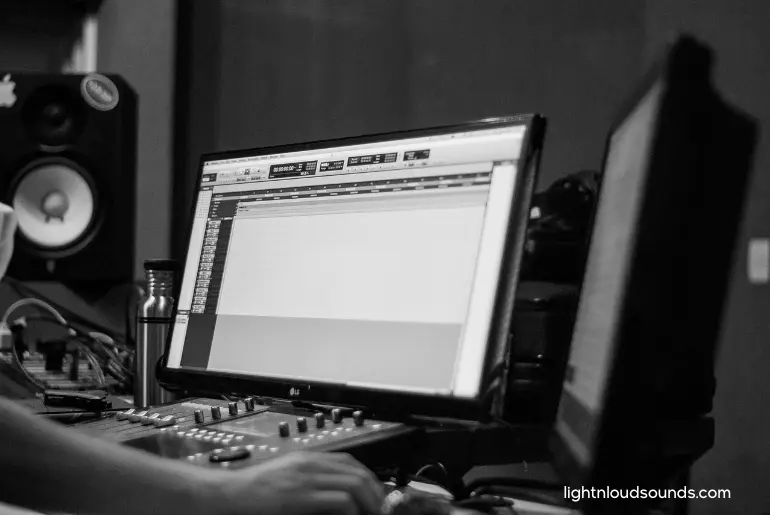In the realm of video production, audio quality is as critical as the visual elements. An optimal audio level ensures clarity, immersion, and effective communication of the content. A commonly used unit to measure audio loudness is decibels (dB). But what is the ideal dB level for audio in videos?
In this post, we’ll discuss the recommended audio levels for videos and the implications of straying from these standards.
Post Contents
What dB Should Audio Be in Video?
For videos, the recommended average audio level for dialogue is between -12dB and -6dB. However, it’s essential to ensure that peak levels do not exceed -3dB to avoid distortion or clipping.
Background music or ambient sounds should typically be set lower than the dialogue, usually around -18dB to -14dB, to ensure the spoken content remains clear and intelligible to the viewers. Adjustments might be needed based on the video’s specific context and desired effect.
What Are the Implications of Straying from dB Levels?
1. Distortion and clipping
If audio levels are set too high, surpassing the 0dB threshold, it can result in distortion or clipping. Clipping means that the audio waveform is “cut off” at its peak, leading to a harsh and unpleasant sound. This can make the audio difficult to understand and reduce the overall quality of the video.
2. Reduced audibility and clarity
Audio that is set too low, significantly below the recommended dB range, can become inaudible or get drowned out by ambient noise. This can lead to the audience missing critical information or becoming disengaged due to the effort required to discern the audio.
3. Overpowered background sounds
If background music or ambient sounds are too loud (closer to the dB levels of dialogue), they can overshadow or compete with the main audio content, like dialogue or narration. This can confuse viewers and detract from the central message of the video.
4. Audience discomfort
Unbalanced audio levels, either too loud or too soft, can create discomfort for viewers. Abrupt changes in volume or consistently high dB levels might force viewers to constantly adjust their volume settings, leading to a less than optimal viewing experience.
5. Perceived amateur production
Audio is a critical aspect of professional video production. Inconsistencies or extreme dB levels can give the impression of amateur production or lack of attention to detail. This perception can reduce the credibility and impact of the content, regardless of the quality of the visual elements.
How to Set Audio Levels for Video

1. Start with a clean recording
Before setting levels, it’s crucial to ensure that the original recording is clean and free from unwanted noise or distortion. Using quality microphones, windshields, and recording in quiet environments can help achieve a good base audio level.
2. Use meters to monitor levels
Most video editing software provides audio meters that display the loudness of your audio in dB. Regularly monitor these meters when setting your levels. Ideally, your peaks should be around -6dB to -3dB, ensuring you’ve got headroom to avoid distortion.
3. Normalize dialogue
Normalize dialogue levels to a standard range for clarity and consistency, usually between -12dB and -6dB. This ensures that spoken content remains at a consistent level throughout the video, making it easier for the audience to follow.
4. Adjust background and ambient sounds
Background music and ambient sounds should complement, not compete with, the dialogue. Generally, these should be set at a lower level, around -18dB to -14dB, ensuring the spoken content remains clear. However, adjust based on the context: for instance, a dramatic scene might require louder background music.
5. Use compression wisely
Compression can be a useful tool to maintain consistent audio levels. It reduces the dynamic range, ensuring that the loudness doesn’t vary too much between the quietest and loudest parts. However, over-compression can make the audio sound unnatural, so use it judiciously.
6. Test playback on multiple devices
Once you’ve set your audio levels, test the video playback on various devices, such as smartphones, tablets, computers, and TVs. Different devices may reproduce audio differently, so ensuring that your audio sounds good across all potential viewing platforms is essential.
7. Regularly review and adjust
Even after setting initial levels, continue to review the audio throughout the editing process. Adding effects, transitions, or other elements might require you to tweak the audio levels to maintain balance and clarity.
Conclusion
Selecting the right dB level for audio in videos is paramount to ensure an excellent viewing experience. Adhering to the recommended standards will help in delivering clear, audible, and impactful content. As with all aspects of video production, it’s crucial to keep the audience’s experience in mind, and well-balanced audio is essential to that experience.

